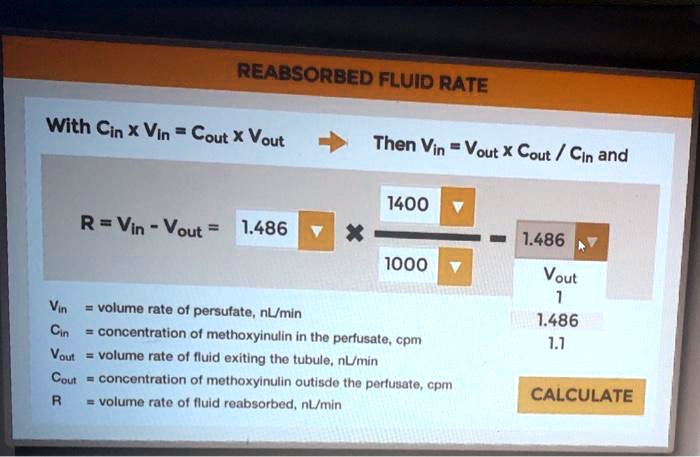Fill the equation on the screen to calculate the reabsorbed delves into the intricate world of renal reabsorption, a crucial process that maintains fluid and electrolyte balance in the body. This comprehensive guide unravels the factors influencing reabsorption, explores the methods used to calculate it, and examines its clinical significance in maintaining homeostasis.
Reabsorption, the selective retrieval of substances from the renal filtrate back into the bloodstream, plays a pivotal role in regulating blood volume, electrolyte concentrations, and pH. Understanding the mechanisms and clinical implications of reabsorption is essential for comprehending renal physiology and diagnosing and managing kidney disorders.
Factors Influencing Reabsorption: Fill The Equation On The Screen To Calculate The Reabsorbed

Reabsorption in the kidney is influenced by various factors that determine the amount of substance that is reabsorbed from the glomerular filtrate back into the bloodstream. These factors can be classified into three main categories: physical, chemical, and physiological.
- Physical factorsinclude the size and charge of the substance, as well as the surface area available for reabsorption. Larger molecules and molecules with a negative charge are generally reabsorbed less efficiently than smaller molecules and molecules with a positive charge.
The surface area available for reabsorption is increased by the presence of microvilli on the luminal surface of the proximal tubule cells.
- Chemical factorsinclude the concentration of the substance in the glomerular filtrate and the presence of other substances that can compete for reabsorption. Substances that are present in high concentrations in the glomerular filtrate are generally reabsorbed more efficiently than substances that are present in low concentrations.
Substances that can compete for reabsorption include other molecules of the same size and charge, as well as molecules that bind to the same carrier proteins.
- Physiological factorsinclude the blood flow rate through the kidney and the hormonal environment. Increased blood flow rate through the kidney can lead to increased reabsorption of substances, as more time is available for reabsorption to occur. Hormones such as antidiuretic hormone (ADH) and aldosterone can also affect reabsorption by regulating the expression of carrier proteins on the luminal surface of the proximal tubule cells.
Methods for Calculating Reabsorption

The reabsorption of a substance can be calculated using a variety of methods, including:
- Clearance: Clearance is the volume of plasma that is completely cleared of a substance per unit time. It can be calculated using the following formula:
Clearance = (Urine concentration- Urine flow rate) / Plasma concentration
Clearance can be used to calculate the reabsorption of a substance by subtracting the clearance of the substance from the glomerular filtration rate (GFR).
- Fractional reabsorption: Fractional reabsorption is the percentage of a substance that is reabsorbed from the glomerular filtrate. It can be calculated using the following formula:
Fractional reabsorption = (Urine concentration- Urine flow rate) / (Plasma concentration – GFR)
Fractional reabsorption can be used to compare the reabsorption of different substances and to assess the efficiency of reabsorption.
Clinical Significance of Reabsorption

Reabsorption is essential for maintaining fluid and electrolyte balance in the body. Impaired reabsorption can lead to a variety of disorders, including:
- Dehydration: Dehydration occurs when the body loses more fluid than it takes in. This can be caused by impaired reabsorption of water in the proximal tubule, which can occur in conditions such as diabetes insipidus.
- Hyponatremia: Hyponatremia occurs when the sodium concentration in the blood is too low. This can be caused by impaired reabsorption of sodium in the proximal tubule, which can occur in conditions such as Addison’s disease.
- Hyperkalemia: Hyperkalemia occurs when the potassium concentration in the blood is too high. This can be caused by impaired reabsorption of potassium in the distal tubule, which can occur in conditions such as renal failure.
Regulation of Reabsorption

Reabsorption is regulated by a variety of hormonal and neural mechanisms. These mechanisms work together to maintain homeostasis by ensuring that the body reabsorbs the appropriate amount of water and electrolytes. Hormonal regulationof reabsorption is primarily mediated by the following hormones:
- Antidiuretic hormone (ADH): ADH is released by the pituitary gland in response to an increase in the osmolality of the blood. ADH acts on the collecting ducts of the kidney to increase the reabsorption of water, which leads to a decrease in urine output and an increase in blood osmolality.
- Aldosterone: Aldosterone is released by the adrenal glands in response to a decrease in the sodium concentration in the blood. Aldosterone acts on the collecting ducts of the kidney to increase the reabsorption of sodium, which leads to an increase in blood sodium concentration.
Neural regulationof reabsorption is primarily mediated by the sympathetic nervous system. The sympathetic nervous system can release norepinephrine, which acts on the afferent arterioles of the glomerulus to constrict them. This leads to a decrease in GFR and an increase in reabsorption.
Essential FAQs
What factors influence reabsorption?
Reabsorption is influenced by factors such as glomerular filtration rate, tubular length and permeability, concentration gradients, and hormonal regulation.
How is reabsorption calculated?
Reabsorption can be calculated using methods such as clearance studies, fractional excretion, and micropuncture techniques.
What is the clinical significance of reabsorption?
Reabsorption is crucial for maintaining fluid and electrolyte balance, and impaired reabsorption can lead to disorders such as dehydration, electrolyte imbalances, and kidney failure.